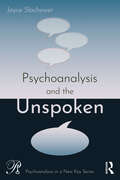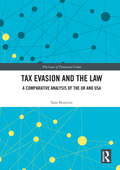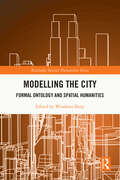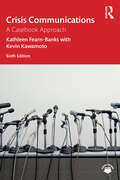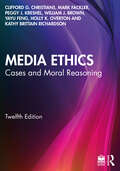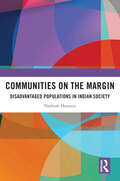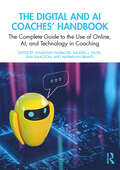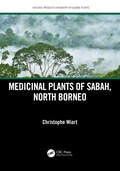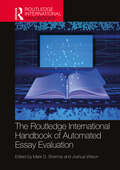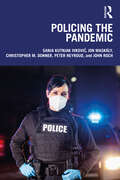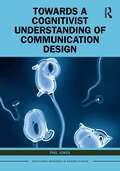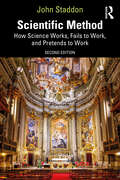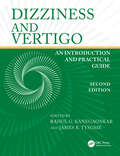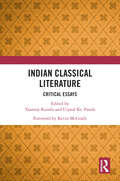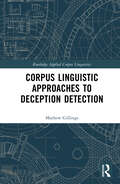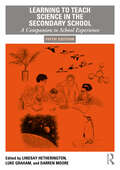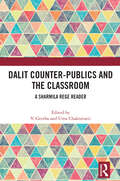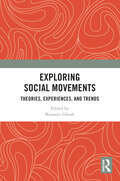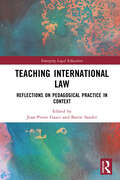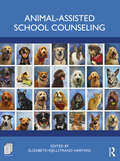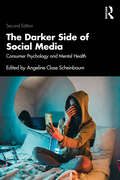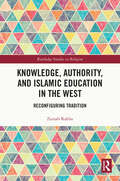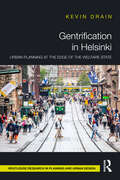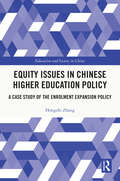- Table View
- List View
Psychoanalysis and the Unspoken (Psychoanalysis in a New Key Book Series)
by Joyce SlochowerWhat do therapists not talk about? What do we ignore/miss/sidestep? What factors—personal, social, political—inform our areas of blindness? This book names and explores what psychoanalytic theory often skips over or simplifies—how, when, and why we fail to uphold the professional ideal. Turning a critical eye on her own theory, Slochower reflects on how it, she, and the field have evolved and what remains unspoken. In so doing, she pushes us to do the same. With its sharp focus on both theory and clinical work, this book is essential reading for psychoanalysts and psychotherapists.
Tax Evasion and the Law: A Comparative Analysis of the UK and USA (ISSN)
by Sam BourtonThis book provides a critical and contemporary evaluation of the laws and enforcement policies pertaining to tax evasion in the United Kingdom (UK) and United States (US). Since the inception of taxes, revenue collection authorities around the world have attempted to address the seemingly perennial problem of individuals evading their tax liabilities. The financial crisis has shone a new light on the issue with an increased interest in using the criminal justice system as a means of addressing it in the UK. In sharp contrast to the UK, the US has a strong record of prosecuting crimes of tax evasion, whether committed by individuals or professional corporate facilitators. Providing an evaluation of the UK’s tax evasion laws and enforcement policy, through a comparative approach, this work highlights insights provided by the US experience. In so doing, the book explores the interconnections between tax evasion and money laundering, identifying best practices, omissions, and areas for reform. The work will be a valuable resource for researchers, academics, and policy-makers working in the areas of financial crime, financial law, accountancy and criminal justice.
Modelling the City: Formal Ontology and Spatial Humanities (Routledge Spatial Humanities Series)
by Wiesława DużyModelling the City focuses on European towns and cities, analysing the opportunities and limitations of modelling of urban space.This book examines how urban space from the past is discovered, explained and presented. It discusses the multitude of historical sources mediating the past urban space, and the structural, technical, and epistemological issues raised around building a domain ontology, including continuity, and change within urban forms and functions.Presentation of a formal domain ontology in spatial humanities makes this book unique and worth reading. It is strongly recommended to readers interested in the linked open data approach to research, data standards in Digital Humanities, urban planning, and old maps.
Crisis Communications: A Casebook Approach (ISSN)
by Kathleen Fearn-Banks Kevin KawamotoNow in its sixth edition, this book provides engaging, practice-oriented case studies analyzing communication professionals’ crisis preparation and responses, illustrating key considerations for communicating with both internal and external stakeholders during and after a crisis.This edition continues its strength as a student-friendly text that demonstrates how to craft, target, and deliver messages during crises in order to mitigate further controversy and distress. Classic cases lay the foundation, while contemporary cases shed light on cutting-edge practices in use today. Many cases from previous editions have been updated and new cases added, including the COVID-19 crisis and U.S. vaccination campaign; Starbucks and racial discrimination at a Philadelphia branch; Will Smith and the Academiy Awards slap; Gander, Newfoundland in supporting stranded tourists after the attacks of September 11, 2001; and a look at how schools can prepare communication responses to school shootings. Each case pays particular attention to the actual and ideal use of social media in the crisis and there is a new section on the important issues of misinformation and disinformation.Crisis Communications, 6th Edition is intended for courses in crisis communication, crisis management, disaster response, corporate communications, and public relations.Student and instructor online support materials feature selected previous editions’ case studies no longer in this edition as well as an Instructor’s Manual with suggested activities, discussion questions, and sample quizzes: www.routledge.com/9780367894450.
Media Ethics: Cases and Moral Reasoning
by Mark Fackler William J. Brown Clifford G. Christians Kathy Brittain Richardson Peggy J. Kreshel Yayu Feng Holly K. OvertonThrough original case studies and analyses of real-life media experiences, Media Ethics challenges readers to think analytically and critically about ethical situations in mediated communication.This textbook provides a comprehensive introduction to the theoretical principles of ethical philosophies, facilitating awareness and critical reflection of ethical issues. In each chapter, the authors examine case studies spanning several continents and geopolitical and cultural contexts. To provide a framework for analyzing the cases and exploring the steps in moral reasoning, the book introduces the Potter Box, a powerful tool for moral analysis. Focusing on a wide range of ethical issues faced by media practitioners and news organizations, the cases in this new twelfth edition include the most prominent concerns in journalism, broadcasting, advertising, public relations, and entertainment today. It explores new topics such as the use of ChatGPT in newsrooms, the privacy implications of biometric technologies, the role of public relations in political campaigns, and advertisers’ approach to sustainability and climate change.This core textbook is ideal for classes in media and communication ethics, journalism, public relations, advertising, entertainment media, and popular culture.Online instructor and student resources, including video introductions to each chapter, PowerPoint slides, sample discussion and exam questions, and links to further resources, are available at www.routledgelearning.com/mediaethics.
Communities on the Margin: Disadvantaged Populations in Indian Society
by Saiyed Nadeemul HasnainThis book probes into the marginalized communities of the Indian society through historical and contemporary societal perspectives. It discusses socio-cultural aspects of the experiences of Scheduled Castes, Dalits, Scheduled Tribes/tribal communities, Other Backward Classes, linguistic minorities, religious minorities and the queer/LGBT as sexual minorities.Adopting an inter-disciplinary approach, it looks at all these segments of Indian society through historical and societal perspectives. Divided into three broad sections – Scheduled Castes, Scheduled Tribes, and minorities, this book provides historical perspective backed by the contemporary situation and emerging social changes among these communities. Written in a lucid manner, the book aims to reach and impact readers without having any prior academic exposure to this subject area.This book would be useful to the students, researchers and teachers of sociology, social work, history, economics, political science, and other interdisciplinary courses in social sciences. The book will also be valuable reading for those interested in South Asian studies, especially contemporary Indian society.
The Digital and AI Coaches' Handbook: The Complete Guide to the Use of Online, AI, and Technology in Coaching (The Coaches' Handbook Series)
by Jonathan Passmore Sam Isaacson Sandra J. Diller Maximilian BrantlThis comprehensive practitioner guide supports coaches in developing their understanding of digital technologies and how to work in ever-changing digital environments, and shows coaches how to craft their own practices to take advantage of working online.The practice of coaching is undergoing significant change, with technology widely embedded and used in professional coaching services today. Coaching practitioners worldwide are adapting to digital environments, and a host of new technological tools have come into play, from the developments in virtual reality to AI-informed coaching, and from coaching bots to workplace apps. Edited by Jonathan Passmore, Sandra J. Diller, Sam Isaacson, and Maximilian Brantl, this third book in the acclaimed Coaches’ Handbook Series brings together internationally respected coaching experts and practitioners to share the most up-to-date know-how. The book takes you through key technical developments, the critical factors in making digital coaching successful, and how to build a coaching business using these technologies. The book also considers the impacts on the wider industry and concludes with a number of case studies of global coaching organisations and their experiences of using digital techniques, including CoachHub and EZRA.Aimed at coach practitioners, their supervisors, trainers, and student coaches on accreditation programmes or undertaking training for a certificate in coaching, this book showcases best practice, new ideas, and the science behind the digital revolution within coaching practice and the coaching industry.
Medicinal Plants of Sabah, North Borneo (Natural Products Chemistry of Global Plants)
by Christophe WiartResearchers in the field of natural product chemistry and pharmacology focus on discovering new drugs from medicinal plants. The medicinal plants of Sabah (North Borneo), many of which are found in all of Asia and the Pacific, represent a vast array of resources that could be used for the discovery of drugs and the development of cosmetics as well as functional food. No other book focuses on the medicinal plants from this part of the globe in such depth. The author is well known in natural products and this text will appeal to a global audience in presenting the botanical description, chemical constituents, pharmacology, pharmaceutical, cosmetic, and functional food potentials of these plants.Features: Describes in a phylogenetic order the habitats, distributions, botanical descriptions, local names, uses, chemical constituents, pharmacological activities, and toxic effects of more than 250 species of medicinal plants of Sabah Provides a selection of botanical plates of medicinal plants endemic to Sabah, hand-drawn by the author Provides comment sections to invite further research on the topic of the development of drugs, dietary products, and cosmetics from Sabah medicinal plants
The Routledge International Handbook of Automated Essay Evaluation (Routledge International Handbooks)
by Joshua Wilson Mark D. ShermisThe Routledge International Handbook of Automated Essay Evaluation (AEE) is a definitive guide at the intersection of automation, artificial intelligence, and education. This volume encapsulates the ongoing advancement of AEE, reflecting its application in both large-scale and classroom-based assessments to support teaching and learning endeavors.It presents a comprehensive overview of AEE's current applications, including its extension into reading, speech, mathematics, and writing research; modern automated feedback systems; critical issues in automated evaluation such as psychometrics, fairness, bias, transparency, and validity; and the technological innovations that fuel current and future developments in this field. As AEE approaches a tipping point of global implementation, this Handbook stands as an essential resource, advocating for the conscientious adoption of AEE tools to enhance educational practices ethically. The Handbook will benefit readers by equipping them with the knowledge to thoughtfully integrate AEE, thereby enriching educational assessment, teaching, and learning worldwide.Aimed at researchers, educators, AEE developers, and policymakers, the Handbook is poised not only to chart the current landscape but also to stimulate scholarly discourse, define and inform best practices, and propel and guide future innovations.
Policing the Pandemic
by Peter Neyroud Sanja Kutnjak Ivković Jon Maskály Christopher M. Donner John RochPolicing the Pandemic explores how police agencies in United Kingdom and the United States have adjusted to their changing environments, both during the peak of the COVID-19 pandemic and later, when the restrictions have been relaxed and the societies have begun to develop their new normal.Combining interviews and surveys of police officers and police administrators from the United Kingdom and the United States, this book provides a systematic and empirically based account of these changes and elaborates on the lessons for the future. The book offers insight into organizational and operational changes brought on by the pandemic, including the changes in their workload, enforcement activities, and administrative changes. It examines police perceptions of, and compliance with, pandemic-related changes, any potential COVID-19-related training, and the frequency with which they used various responses when observing violations of COVID-19 regulations and laws. It also focuses on police officers’ own fear of contracting COVID-19, whether they had been diagnosed with COVID-19, and how the pandemic affected their own health, stress, and general well-being.This book is an essential reading for scholars, policymakers, and police administrators tackling issues such as procedural justice, organizational change, and police officer well-being, as well as those more widely engaged with societal and legal consequences of the pandemic, be it the COVID-19 pandemic or any future pandemics.
Towards a Cognitivist Understanding of Communication Design (Routledge Research in Design Studies)
by Phil JonesThis book demonstrates the relevance and importance of cognitive linguistics when applied to the analysis and practice of graphic design/communication design. Phil Jones brings together a diverse range of theory and organizes it in accordance with different stages in the design process. Using examples from contemporary communication design, as well as more familiar selections from the graphic design canon as case studies, this book provides an account of how meanings are made by users, and suggests new strategies for design practice. It seeks convergences between the ways that graphic/communication designers think and talk about their practice and the theories emerging from cognitive science. This book will be of interest to scholars working in design, graphic design, the philosophy of art and aesthetics, communication studies, and media and film studies.
Scientific Method: How Science Works, Fails to Work, and Pretends to Work
by John StaddonThis expanded second edition of Scientific Method shows how science works, fails to work or pretends to work by looking at examples from physics, biomedicine, psychology, sociology and economics.Scientific Method aims to help curious readers understand the idea of science, not by learning a list of techniques but through examples both historical and contemporary. Staddon affirms that if the reader can understand successful studies as well as studies that appear to be scientific but are not, they will become a better judge of the “science” in circulation today. To this end, this new edition includes a new chapter, What is Science?, which points out that science, like any human activity, has its own set of values, with truth being the core. Other new chapters focus on the emergence of AI and machine learning, science and diversity, and behavioral economics. The book also includes textual features such as bullet-points and text boxes on topical issues.Scientific Method is essential reading for students and professionals trying to make sense of the role of science in society, and of the meaning, value and limitations of scientific methodology.
The French Revolution and Napoleon: A Sourcebook
by Philip Dwyer Peter McPheeThis volume collects together a wide selection of primary texts that explain the processes behind the enormous changes undergone by France and Europe between 1787 and 1815, from the origins of the Revolution to the counterrevolution and from Marie-Antoinette to Bonaparte.The achievements, terror and drama of the French Revolutionary and Napoleonic period restructured politics and society on a grand scale, making this the defining moment for modern European history. While bringing the impact of historical events to life, Philip Dwyer and Peter McPhee provide a clear outline of the period through the selection of key documents, lucid introductory passages and commentary. They illustrate the meaning of the Revolution for peasants, sans- culottes, women and slaves, as well as placing events within a wider European and global context.Students will find this an invaluable source of information on the Revolution and its international significance.
Dizziness and Vertigo: An Introduction and Practical Guide
by James R. Tysome Rahul G. KanegaonkarDizziness and Vertigo describes the basic knowledge and practical skills necessary for managing patients presenting with common symptoms of dizziness and vertigo. It provides practitioners with a comprehensive overview of these conditions, steps for diagnosing patients and various treatment options.This revised and updated edition provides a framework for the accurate diagnosis and management of patients with dizziness and vertigo, covering clinical assessments and case studies. It also includes new methods for treating Ménière’s disease and benign paroxysmal positional vertigo (BPPV) and in the field of vestibular rehabilitation.Dizziness and Vertigo is an essential reference for all those who manage patients in the outpatient setting, including general practice trainees, ear/nose/throat (ENT) specialists and physiotherapists.
Indian Classical Literature: Critical Essays
by Tanmoy Kundu and Ujjwal Kr. PandaThis book critically analyses classical Indian literature and explores the philosophical, literary, and cultural landscapes which have emerged in response to ancient Indian texts. It highlights the relevance of these texts and studies and how they have come to influence modern Indian literature in various ways. The authors look at classical literature both as a theoretical premise that primarily seeks to develop new knowledge and as a sphere of serious modern/postmodern critical attention. The volume features essays on key texts including Abhijnanasakuntalam, The Cilappatikaram: A Tale of An Anklet, Mrichchakatika, Panchatantra, and Mahabharata.A useful guide to ancient Indian texts, the book will be indispensable for students and researchers of mythology and classical literature, literary and critical theory, Indian literature, Sanskrit studies, and South Asian studies.
Corpus Linguistic Approaches to Deception Detection (ISSN)
by Mathew GillingsCorpus Linguistic Approaches to Deception Detection provides an innovative introduction to the use of the corpus linguistics methodology in the field of deception detection.Bringing together research from both forensic psychology and linguistics, this book uses traditional corpus-assisted methods to reconcile the different approaches used by these two fields and shows how “cues to deception” operate in their linguistic context. Arguing that current methods of analysis do not seem to be fit for purpose, this book shows the need for further development of context-sensitive methods to explore deceptive datasets.This book will be of interest to scholars and postgraduate students in the fields of corpus linguistics, psychology, discourse analysis, and forensic linguistics.
Learning to Teach Science in the Secondary School: A Companion to School Experience (ISSN)
by Lindsay Hetherington Luke Graham Darren MooreLearning to Teach Science in the Secondary School is an indispensable guide to the process, practice, and reality of learning to teach science in a busy secondary school. Written by experienced teachers and expert academics, it explores core debates and topics in science education, providing practical and insightful advice with research and theory to support your development as a teacher.This fully updated fifth edition focuses on the knowledge and skills you will need to develop your science teaching including key approaches to teaching physics, chemistry, and biology, lesson and curriculum planning, and assessment. There are also new chapters on: Safety in science teaching The science of learning for teaching science Mathematics and learning science Science for social justice Inclusive and adaptive science teaching Making use of research: practical guidance for science teachers Written with university and school-based initial teacher education in mind and including learning objectives, lists of useful resources, and specially designed tasks in every chapter Learning to Teach Science in the Secondary School offers all student and early career teachers accessible and comprehensive guidance to support the journey of becoming an effective science teacher.
Dalit Counter-publics and the Classroom: A Sharmila Rege Reader
by Uma Chakravarti V. GeethaThis book is an anthology of the collected essays of Sharmila Rege (1964 – 2013) that addresses themes to do with pedagogy and culture. Rege makes a compelling argument for rethinking the content of sociological knowledge and invokes in this context, Anticaste radical philosophies, associated with Mahatma Phule and Babasaheb Ambedkar as well as the writings of Dalit women. Equally, she seeks to rethink and engender the domain of Cultural Studies. She calls attention to 'Dalit counter-publics', comprising performance and commemorative traditions that are committed to ending the caste order and argues for a critical rethinking of the relationship between caste, sexuality, and popular culture.Framed and annotated by an introduction that places Sharmila's work in the intellectual and historical contexts that shaped it, the volume also features short prefatory notes by her colleagues on the various themes taken up for discussion. Addressing, as it does, the researcher, the activist and the teacher, the book is indispensable for students and researchers of Women’s Studies, feminism, gender studies, Dalit Studies, minority studies, Sociology, Cultural Studies, Performance Studies, as well as studies in language and rhetoric.
Exploring Social Movements: Theories, Experiences, and Trends
by Biswajit GhoshThis book introduces the readers to the dynamics of various kinds of social movements. It examines how social movements have become an instrument of social change including assertion of identity and protest against marginalisation. This book describes three major domains – conceptual, experiential, and the impact of globalisation on social movements. The volume begins by locating social movements within broad and contemporary social processes and explores the intrinsic and complex patterns of dynamics among state, market, and social movements from a critical sociological perspective. It explains the meaning, basic features, origins and types, leadership and ideology, and perspectives of social movements and probes into major experiences of eight social movements in India, namely, peasant and farmers, tribal, Naxalite and Maoist, Dalit, working class, women, ethnic, and environmental movements. This book also analyses the role of information technology, media, and civil society in the spread and continuation of such movements. The experiences of queer, new religious, anti-systemic, and anti-displacement movements would also help readers understand how globalisation has offered new avenues of protest to diverse sections of the population. Lessons of anti-globalisation movements across the world provide a futuristic perspective in assessing the strength of social movements in a global society.This book will be useful to the students, researchers, and faculty working in the field of political science, sociology, gender studies, and post-colonial contemporary Indian politics in particular. It will also be an invaluable and interesting reading for those interested in South Asian studies.
Teaching International Law: Reflections on Pedagogical Practice in Context (ISSN)
by Barrie Sander Jean-Pierre GauciThe practice of teaching international law is conducted in a wide range of contexts across the world by a host of different actors – including scholars, practitioners, civil society groups, governments, and international organisations.This collection brings together a diversity of scholars and practitioners to share their experiences and critically reflect on current practices of teaching international law across different contexts, traditions, and perspectives to develop existing conversations and spark fresh ones concerning teaching practices within the field of international law. Reflecting on the responsibilities of teachers of international law to engage with and confront histories, contemporary crises, and everyday events in their teaching, the collection explores efforts to decenter the teacher and the law in the classroom, opportunities for dialogical and critical approaches to teaching, and the possibilities of co-producing non-conventional pedagogies that question the mainstream underpinnings of international law teaching. Focusing on the tools and techniques used to teach international law to date, the collection examines the teaching of international law in different contexts. Traversing a range of domestic and regional contexts around the world, the book offers insights into both the culture of teaching in particular domestic settings, aswell as the structural challenges and obstacles that arise in terms of who, what, and how international law is taught in practice.Offering a unique window into the personal experiences of a diversity of scholars and practitioners from around the world, this collection aims to nurture conversations about the responsibilities, approaches, opportunities, and challenges of teaching international law.
Animal-Assisted School Counseling
by Elizabeth Kjellstrand HartwigAnimal-Assisted School Counseling (AASC) is a hands-on resource that provides invaluable information for school counselors interested in partnering with a therapy animal on campus to help students meet social and emotional goals. This book presents a wealth of resources for school counselors and school-based mental health practitioners to incorporate animal partners on school campuses with individual students and groups and in classroom and schoolwide settings. Using the American School Counselor Association (ASCA)National Model framework, this book presents AASC interventions that can be implemented as part of the multitiered system of support to address students’ mental health needs. The text also meets the important demand for accountability in school counseling by providing resources for assessing the effectiveness of AASC interventions for meeting student and school outcome goals. Addressing such issues as getting school district buy-in, choosing an animal partner, preparing the school for an animal partner, theoretical applications of AASC, and student-affirming AASC services, the book is organized such that each chapter builds upon the next so school counselors understand what steps to take to become an effective AASC team. Ideal for the school counselor, social worker, or psychologist who may not have specific training in AASC, this book will encourage school mental health practitioners to seek out training programs to become an AASC team.
The Darker Side of Social Media: Consumer Psychology and Mental Health
by Angeline Close ScheinbaumThe Darker Side of Social Media: Consumer Psychology and Mental Health takes a research-based, scientific approach to examining problematic issues and outcomes that are related to social media use by consumers. Now in its second edition, it relies on psychological theories to help explain or predict problematic online behavior within the social media landscape through the lens of mental health.With an aim to provide solutions, the authors spotlight the key issues affecting consumer well-being and mental health due to the omnipresence and overuse of social media. The book dissects the unintended consequences of too much social media use, specifying key problems like disconnection anxiety, eating disorders, online fraud, cyberbullying, the dark web, addiction, depression, self-discrepancies, and serious privacy concerns (especially impacting children or young people). The book provides grapples with mental health disorders such as anxiety, depression, self-harm, and eating disorders that can be intensified by, or correlated with, too much social media use. The authors meticulously review the various facets of the darker side of online presence and propose actionable solutions for each of the problems stated, providing scholars with a conceptual model with propositions for continued research.This international exploration of social media is a must-read for students of marketing, advertising, and public relations, as well as scholars/managers of business, marketing, psychology, communication, management, and sociology. It will also be of interest to social media users, those navigating new media platforms parents, policymakers, and practitioners.
Knowledge, Authority, and Islamic Education in the West: Reconfiguring Tradition (Routledge Studies in Religion)
by Zainab KabbaDrawing on immersive fieldwork in the United States, Canada, and Turkey, this ethnographic exploration illuminates the transformative experiences of emerging adult Muslims on their quest for religious knowledge. This book unravels the significance of four residential learning settings, revealing their role as catalysts for reshaping Islamic tradition. Delving into the interplay between technology’s pervasive influence and the decentralized nature of Islamic interpretation, Zainab Kabba unveils a vibrant tapestry of knowledge producers vying to shape religious understanding and practice among Western Muslims. At the heart of this narrative lies the delicate balance between teachers and students, continuously communicating and recalibrating components that bring religious authority to life. Kabba dissects this relationship, highlighting the emergence of a complex landscape that she terms the ‘Muslim Education Industrial Complex’, where religious knowledge has become a commodity. This study offers profound insights into the challenges of intra-Muslim dialogue and the adaptive resilience of American Sunni-Muslim communities. Amidst a digital age and the complexities of global geopolitics surrounding Islam, it showcases how these communities reinterpret classical Islamic narratives, navigating tradition to steer their path forward. This book invites readers to ponder the evolution of Islamic learning, the dynamics of authority, and the enduring quest for knowledge amidst the currents of a rapidly changing world.
Gentrification in Helsinki: Urban Planning at the Edge of the Welfare State (Routledge Research in Planning and Urban Design)
by Kevin DrainThis book unravels the paradox of gentrification in Helsinki, Finland. Here, housing and welfare policies work well under certain conditions to prevent the worst outcomes of residential gentrification. Yet other forms of gentrification have proliferated in recent years, and local urban planning has gained a momentum in efforts to remake the urban landscape for business and tourism.Through a range of methods, each chapter approaches a different aspect of gentrification: the effectiveness of welfare policies against residential gentrification, the importance of retail gentrification and symbolic changes, the role of media and state-led tourism campaigns in promoting gentrification, the rise of vibrancy and sustainability as concepts driving regeneration, and the question of planning principles like participation in confronting gentrification. The reader will find a state system that supports a delicate balance in housing, but a local planning regime related to a more “generalized” gentrification. The results raise questions about the limits of the welfare state in an age of global competition.While new readers of gentrification will benefit from a deep engagement with the literature, the case of Helsinki is relevant to all students of planning, social sciences, and urban studies, as well as professionals in related fields.
Equity Issues in Chinese Higher Education Policy: A Case Study of the Enrolment Expansion Policy (ISSN)
by Hongzhi ZhangInvestigating the highly influential enrolment expansion policy in Chinese higher education, this book outlines how educational equity issues were understood and addressed in the formulation and implementation of the policy, and its impacts on the socio-economic fabric of China in the past decades.Drawing on Chinese policy documents and interviews with government and university representatives, Zhang examines the education system under the Mao era and the post-Mao era and outlines the different approaches to equity that have characterized education in China in the 20th and 21st centuries. Stephen Ball’s "policy cycle" is used as a framework to analyse the various contexts (text, discourse, and social practice) in which policy is formed. Zhang argues that education policy was not simply driven by concerns of equity but also by economic interests and political discourse. Zhang further goes on to analyse how education policy was implemented by provincial governments and highlights the tension between central policy and on-the-ground implementation.Bringing analysis of Chinese policy and research to a wider audience, this text will interest education policymakers and academics in the field of educational equity and higher education research.
